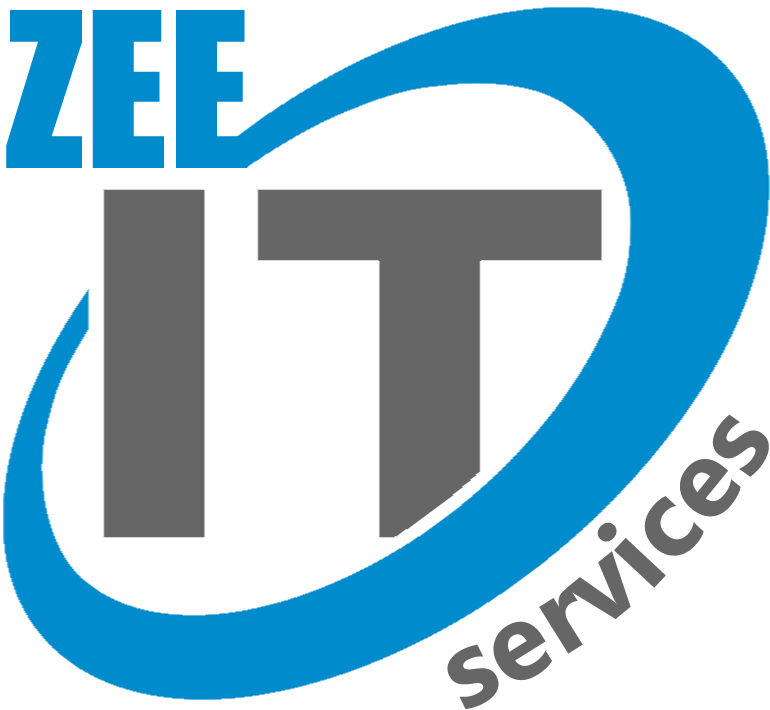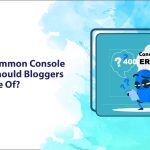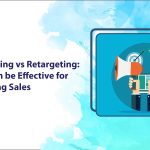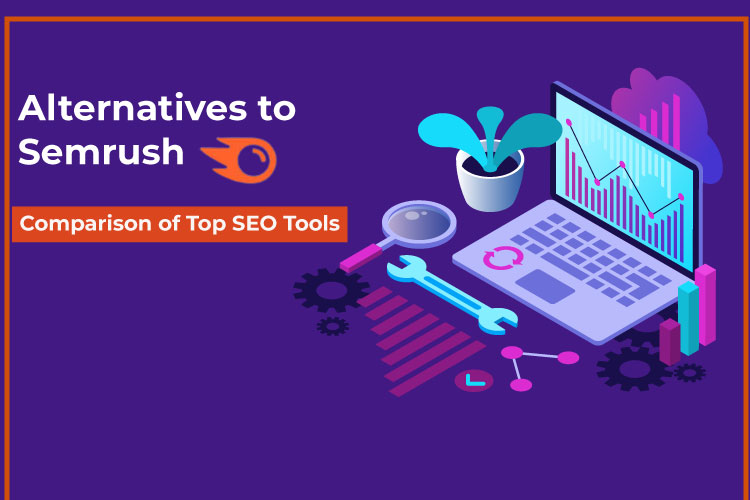
Oct 5, 2023 | Blogs
Digital marketing strategies cannot be successful without SEO optimization. To excel in the online landscape, businesses rely on SEO tools to analyze, strategize, and enhance their online presence. SEMrush has long been a prominent player in the field, but as the digital world evolves, exploring alternatives to SEMrush is a prudent move. We compare the top SEO tools, evaluating their features, benefits, and drawbacks, to provide you with insights that can help you optimize your website.
Introduction to Semrush
Let’s first discuss SEmrush briefly so those who are unfamiliar with it can understand it before going onto SEmrush’s alternatives. Semrush is a robust and versatile digital marketing toolkit that empowers businesses and individuals to excel in the competitive world of online marketing. It offers a wide range of tools and features designed to optimize various aspects of digital marketing, including SEO (Search Engine Optimization), PPC (Pay-Per-Click) advertising, content marketing, social media management, and also competitive analysis. Moreover, It is an indispensable asset for businesses and professionals seeking to thrive in the digital age.
Key Features to Look for in an SEO Tool
Before we embark on our journey to explore SEMrush alternatives, it’s crucial to understand the key attributes that make an SEO tool effective:
- Comprehensive Keyword Research: A strong SEO tool should provide in-depth keyword analysis to help you target the right audience.
- Backlink Analysis: Backlinks remain a cornerstone of SEO. Moreover, An effective tool should offer insights into competitors’ backlinks and suggest opportunities for your site.
- Site Audits: Regular site audits identify issues that may be affecting your site’s performance in search results.
- Rank Tracking: Keeping tabs on your keyword rankings helps measure the effectiveness of your SEO efforts.
- Competitor Analysis: Understanding your competitors’ strategies can provide valuable insights for your campaigns.
Ahrefs
Ahrefs is a robust SEO tool that provides a wealth of data and insights to help businesses optimize their online presence. This multifaceted platform offers a wide range of features designed to enhance SEO efforts and boost organic traffic. Furthermore, Let’s take a closer look at what Ahrefs brings to the table.
Pros of Ahrefs
- Comprehensive Backlink Analysis
- boasts an extensive keyword database
- Perform in-depth competitor analysis
- provides a comprehensive site audit
Cons of Ahrefs
- Ahrefs can be relatively expensive
- Steep Learning Curve
Features of Ahrefs
Moreover, Ahrefs is an excellent option in the SEO tool market due to the following notable features:
Site Explorer
Ahrefs’ Site Explorer provides a comprehensive overview of a website’s performance, including backlinks, referring domains, organic keywords, and more.
Keyword Explorer
This feature allows users to conduct in-depth keyword research, uncovering valuable insights into keyword difficulty, search volume, and click-through rates.
Content Explorer
Ahrefs’ Content Explorer helps users discover top-performing content in their niche, making it easier to craft content that resonates with the target audience.
Rank Tracker
Tracking keyword rankings is a breeze with Ahrefs’ Rank Tracker, allowing users to monitor their SEO progress over time.
Ahrefs vs. SEMrush
Now, let’s compare Ahrefs and SEMrush to help you make an informed choice for your SEO endeavors.
Ahrefs
- Excels in backlink analysis.
- Offers a comprehensive keyword research tool.
- Provides valuable insights for competitor analysis.
- Offers a site audit feature for on-page SEO optimization.
SEMrush
- powerful SEO suite with a focus on competitor analysis.
- Offers a content marketing toolkit
- Provides a social media toolkit
- and robust advertising toolkit for PPC campaigns.
Moz
Moz offers an all-inclusive SEO toolkit that covers everything from keyword research to site audits. Its user-friendly interface makes it a great choice for beginners, while its advanced features cater to the needs of seasoned SEO professionals. Moreover, The Moz “Domain Authority” metric has become a standard in the industry, providing insights into a website’s credibility and search engine ranking potential.
Pros and Cons of Moz
Pros:
- It offers a Comprehensive SEO Suite
- The platform provides User-Friendly Interface
- It provides Accurate Keyword Research:
- Gain valuable insights into your competitor’s analysis
- It helps you with Content Recommendations
Cons:
- Moz can be relatively expensive
- Intensive learning curve
- It provides Limited Social Media Tools
Features of Moz
Furthermore, A wide range of SEO and digital marketing-related features are available from Moz. Here are some distinguishing characteristics of Moz:
Keyword Research and Analysis
You can find profitable keywords, evaluate their difficulty, and monitor your keyword rankings over time with Moz’s keyword research tool. This function is crucial for content optimization and staying on top of SEO trends.
Site Audits and Crawling
Moz’s site audit tool helps you identify and rectify on-page SEO issues, ensuring your website is in top-notch shape for search engines.
Link Building
Building high-quality backlinks is essential for SEO success. Moz also provides tools to help you find link-building opportunities and monitor your link profile.
Rank Tracking
Track your website’s search engine rankings for specific keywords and see how your performance evolves over time.
On-Page Optimization
Optimize your website’s pages with Moz’s on-page optimization recommendations, ensuring they align with best SEO practices.
Content Recommendations
Moz’s content suggestions guide you in creating valuable and relevant content that resonates with your target audience.
Moz vs. SEMrush
Moz:
- Robust keyword research with Keyword Explorer.
- Strong focus on link analysis and backlink insights.
- Site audit feature to identify and fix technical SEO issues.
- Local SEO tools for businesses with physical locations.
- User-friendly interface and extensive educational resources.
SEMrush:
- Comprehensive keyword research with the Keyword Magic Tool.
- Advanced competitor analysis for strategic insights.
- Site health check through the Site Audit tool.
- Extensive content marketing features for SEO-friendly content.
- User-friendly interface with a strong knowledge base and customer support.
SE Ranking
SE Ranking offers a comprehensive suite of SEO tools that encompass keyword tracking, competitor analysis, and on-page optimization. One of its standout features is “Page Changes Monitoring,” which notifies users about any alterations to monitored web pages. Moreover, This tool proves invaluable for keeping an eye on both your website and your competitors.
Pros and Cons of SE Ranking
Pros
- It offers a wide array of SEO analysis tools
- Provide User-Friendly Interface
- Provide Accurate Rank Tracking
- Detailed Competitor Analysis:
- generate white-label reports
Cons
- It offers a Limited Free Plan
- Keyword research could be better
- The database is not that big
Key Features of SE Ranking
Additionally, SE Ranking is packed with features to help you boost your website’s SEO. Here are some of the standout features:
Keyword Research
Choose the keywords that are most relevant to your niche and monitor their evolution over time. Insights about keyword difficulty, search volume, and other factors are provided by SE Ranking.
On-Page SEO Audit
Ensure your website is optimized for search engines. SE Ranking’s audit tool checks for on-page SEO issues and suggests improvements.
Backlink Analysis
Backlinks play a crucial role in SEO. SE Ranking helps you analyze your backlink profile and discover new linking opportunities.
Competitor Research
Stay one step ahead of your competitors by tracking their SEO strategies, keywords, and backlinks.
Rank Tracking
Monitor your website’s ranking on various search engines with accuracy.
Social Media Management
SE Ranking also offers tools for social media management, allowing you to schedule posts and track their performance.
SE Ranking Vs. Semrush
SE Ranking and Semrush are both powerful SEO tools, but they have distinct features and advantages.
SE Ranking
- SE Ranking is known for its user-friendly interface, making it an excellent choice for beginners.
- It offers white-label reporting, making it suitable for agencies and freelancers.
- SE Ranking’s pricing is competitive, making it more accessible for smaller businesses.
Semrush
- Semrush is a comprehensive digital marketing toolkit that includes SEO, PPC, and content marketing tools.
- It provides a vast amount of data and is favored by larger enterprises and marketing professionals.
- Semrush also offers in-depth competitor analysis and research tools.
Ubersuggest
Neil Patel created Ubersuggest with the goal of streamlining keyword research. It is a desirable option for small firms and solo entrepreneurs because of its user-friendly interface and reasonable pricing. Ubersuggest offers keyword recommendations, information on search volume, and also perceptions of the best pages of competitors.
Pros of Ubersuggest
- Provide User-Friendly Interface
- extensive range of keyword data
- offers a robust competitive analysis feature
- provide Content Ideas
Cons of Ubersuggest
- Offers limited Free Plan
- Keyword Difficulty Accuracy
Features of Uber suggest
Keyword Research:
Ubersuggest offers thorough keyword information, such as search volume, keyword difficulty, and historical trends. Moreover, You may find effective keywords using this function to improve your content and SEO efforts.
Competitive Analysis:
Ubersuggest allows you to analyze your competitors’ websites. You can uncover their top-performing keywords, backlink profiles, and content strategies, enabling you to stay ahead in your niche.
Content Ideas:
Running out of content ideas? Ubersuggest offers a content ideas feature that helps you discover trending topics and questions in your industry. Moreover, This ensures your content remains relevant and engaging to your audience.
Site Audit:
Ubersuggest can perform a site audit to identify SEO issues on your website. It provides recommendations to improve your site’s performance, user experience, and search engine rankings.
Backlink Analysis:
Backlinks are crucial for SEO success. Ubersuggest helps you analyze your backlink profile and track new and lost backlinks. You can also spy on your competitor’s backlinks to find new linking opportunities.
Local SEO:
For businesses targeting local markets, Ubersuggest offers local SEO features. You can track local keyword rankings, analyze local competitors, and optimize your website for local search results.
Ubersuggest Vs. Semrush
Furthermore, Let’s now compare Semrush, another powerhouse in the SEO tool world, to Ubersuggest.
Ubersuggest
- Ideal for beginners with its user-friendly interface.
- Affordable pricing, including a free plan.
- Valuable competitive analysis features.
- Content ideas to keep your content strategy fresh.
Semrush
- A more comprehensive tool for advanced SEO professionals.
- In-depth competitor analysis with a focus on organic search.
- Robust site audit and backlink analysis.
- Extensive database for global keyword research.
SpyFu
SpyFu specializes in competitor analysis, helping you uncover your competitors’ most profitable keywords and ad campaigns. By analyzing your competitors’ strategies, you can fine-tune your own approach. Additionally, SpyFu offers historical data, allowing you to track changes in competitors’ strategies over time.
Pros and Cons
Pros of SpyFu
- Provide Comprehensive Competitor Analysis
- Provide Historical Data
- Affordable Pricing
- User-Friendly Interface
Cons of SpyFu
- Limited Data for Smaller Websites
- Unlike Semrush, SpyFu doesn’t offer content analysis tools.
Features
Keyword Research
You may find the most valuable keywords in your niche with SpyFu’s comprehensive keyword research tool. You may evaluate the level of competition for each keyword and pinpoint weak points in your plan.
Competitor Analysis
One of SpyFu’s standout features is its competitor analysis. You can spy on your competitors’ keywords, ad campaigns, and backlinks. This data empowers you to refine your own strategies and stay one step ahead.
PPC Research
For advertisers, SpyFu provides comprehensive PPC (Pay-Per-Click) research. You can uncover your competitors’ ad spend, the keywords they target, and their ad copy. This information is vital for optimizing your ad campaigns.
Backlink Analysis
Backlinks are crucial for SEO success. SpyFu’s backlink analysis tool helps you identify your competitors’ most valuable backlinks, allowing you to target the same sources and boost your website’s authority.
Rank Tracking
SpyFu allows you to monitor your website’s search engine rankings for specific keywords. You can track your progress over time and make data-driven adjustments to your SEO strategy.
SpyFu Vs Semrush
When it comes to choosing between SpyFu and Semrush, both tools have their strengths. Moreover, The right choice depends on your specific needs and budget.
SpyFu
- SpyFu offers more budget-friendly plans, making it a better choice for smaller businesses and startups.
- SpyFu’s historical keyword data is a unique advantage, but Semrush’s database is larger and more
- SpyFu specializes in competitor analysis, making it the go-to choice if this is your primary focus.
Semrush
- Semrush has a broader range of pricing plans, catering to both small businesses and large enterprises.
- Semrush’s keyword research tool provides more comprehensive insights into long-tail keywords and search trends.
- Semrush also offers competitor analysis tools but is more versatile in terms of overall SEO capabilities.
Majestic SEO
Majestic SEO specializes in backlink analysis, emphasizing the importance of quality over quantity. Its “Trust Flow” and “Citation Flow” metrics assist in evaluating the credibility of websites. Furthermore, Majestic SEO’s data can aid in making informed decisions about link-building strategies that align with search engine guidelines.
Pros and Cons
Pros
- Provide In-Depth Backlink Analysis
- Trustworthy Data
- Competitive Analysis
- intuitive and User-Friendly Interface
- Customizable Reports
Cons
- Learning Curve
- Limited Keyword Research
- No Content Analysis
Features
Now that we’ve explored the pros and cons, let’s delve into the standout features of Majestic SEO.
Backlink Analysis
Majestic SEO’s bread and butter are its backlink analysis tools. You can easily uncover crucial information about your website’s backlinks, including their quality, source, and anchor text. This data is invaluable for devising a robust link-building strategy.
Trust Flow and Citation Flow
Majestic SEO introduces two essential metrics: Trust Flow and Citation Flow. Trust Flow measures the quality of backlinks, while Citation Flow assesses the quantity. Additionally, These metrics provide a holistic view of your website’s link profile.
Site Explorer
You may discover more about any website or URL with the Site Explorer function. You can investigate the websites of your rivals, understand their backlinking tactics, and spot areas for development.
Keyword Checker
While not as extensive as Semrush’s keyword research tools, Majestic SEO’s Keyword Checker still offers valuable insights into keyword competitiveness and search volume.
SEO Campaigns
Majestic SEO enables you to create and manage SEO campaigns effortlessly. You can track your website’s performance, monitor backlink changes, and stay on top of your SEO efforts.
Majestic SEO Vs. Semrush
Now, let’s put Majestic SEO and Semrush side by side for a direct comparison.
- Majestic SEO: Offers comprehensive backlink analysis with Trust Flow and Citation Flow metrics.
- Semrush Provides detailed backlink data, including referring domains and anchor text distribution.
- Majestic SEO: Offers basic keyword research capabilities.
- Semrush: Excels in keyword research with extensive keyword databases and competitive analysis tools.
- Majestic SEO: Lacks content analysis features.
- Semrush: Provides in-depth content analysis, including SEO recommendations and content optimization tools.
- Majestic SEO: User-friendly interface suitable for both beginners and experts.
- Semrush: User-friendly with a slight learning curve due to the abundance of features.
- Majestic SEO: Offers various pricing plans, with a free version available.
- Semrush: Pricier than Majestic SEO but offers a broader range of tools and features.
Screaming Frog
Screaming Frog is a desktop application that performs in-depth site audits. It crawls websites to identify on-page SEO issues, such as broken links and duplicate content. This tool’s insights contribute to improved user experience and higher search engine rankings.
Pros and Cons
Furthermore, Let’s examine what makes Screaming Frog shine and where it might fall short compared to Semrush.
Pros of Screaming Frog
- In-Depth Website Crawling
- Provide Customization and unparalleled flexibility
- cost-effective solution
- release Regular Updates
Cons of Screaming Frog
- Steep Learning Curve
- Lack of Real-Time Data
- Limited Competitive Analysis
Features
Let’s dig deeper into the standout features that make Screaming Frog a formidable alternative to Semrush.
Comprehensive Crawling
The crawling powers of Screaming Frog are unmatched. Like a search engine bot, it crawls your website, examining each page and delivering important information like the HTTP status, title tags, meta descriptions, and more.
Data Export and Integration
Screaming Frog allows you to export your crawl data in various formats, making it easy to analyze and share with your team. Plus, it integrates seamlessly with other SEO tools and platforms.
Detailed Reports
The tool generates detailed reports highlighting issues like broken links, missing metadata, and duplicate content. Moreover, These reports are invaluable for prioritizing SEO fixes.
XML Sitemap Generation
Screaming Frog can generate XML sitemaps for your website, making it easier for search engines to index your content.
JavaScript Rendering
In an era where JavaScript-driven websites are common, Screaming Frog has you covered. It can render JavaScript, ensuring a comprehensive crawl.
Structured Data Analysis
The tool helps you evaluate structured data markup on your site, ensuring that search engines understand your content better.
Website Visualization
With Screaming Frog, you can use a special visualization function to examine how the pages on your website are related to one another.
Screaming Frog vs. Semrush
Now that we’ve explored the ins and outs of Screaming Frog, Furthermore, let’s compare it to the SEO giant, Semrush.
- Screaming Frog: Offers unparalleled depth in on-page SEO data.
- Semrush: Provides comprehensive SEO data, including competitive insights and historical trends.
- Screaming Frog: Has a steeper learning curve and is more suited for seasoned SEO professionals.
- Semrush: Offers a more intuitive user experience, making it accessible to both beginners and experts.
- Screaming Frog: Offers a more budget-friendly option, making it ideal for small to medium-sized businesses.
- Semrush: Tends to be pricier, catering to larger enterprises.
- Screaming Frog: Provides data based on the latest crawl, but it’s not real-time.
- Semrush: Offers real-time data, especially crucial for tracking live campaigns.
- Screaming Frog: Lacks in-depth competitor analysis features.
- Semrush: Excels in competitive research, helping you stay ahead in your niche.
Why choose Zee IT Services?
Unlock the full potential of your online presence with ZEE IT Services! Our expert team specializes in supercharging your SEO strategy using a diverse array of cutting-edge SEO tools. With our tailored approach and industry-leading tools, we transform your website into an SEO powerhouse. From keyword research to competitive analysis, we harness the power of data to drive your website to the top of search engine rankings. Let’s make your website the shining star in the digital galaxy. Discover the future of SEO with ZEE IT Services!
Frequently Asked Questions
Is SEMrush the only comprehensive SEO tool?
SEMrush is one of many excellent SEO tools available. Depending on your needs, other tools might be more suitable.
How does Ubersuggest compare to other SEO tools on the market?
Ubersuggest holds its ground in terms of affordability and user-friendliness. However, for advanced features and in-depth analysis, other tools like Semrush might be more suitable.
Can I switch between these tools easily?
While there might be a learning curve, most tools offer migration options to make the transition smoother.
How does Moz’s keyword research compare to SEMrush?
Moz’s Keyword Explorer is known for its accuracy and provides valuable insights into keyword difficulty.
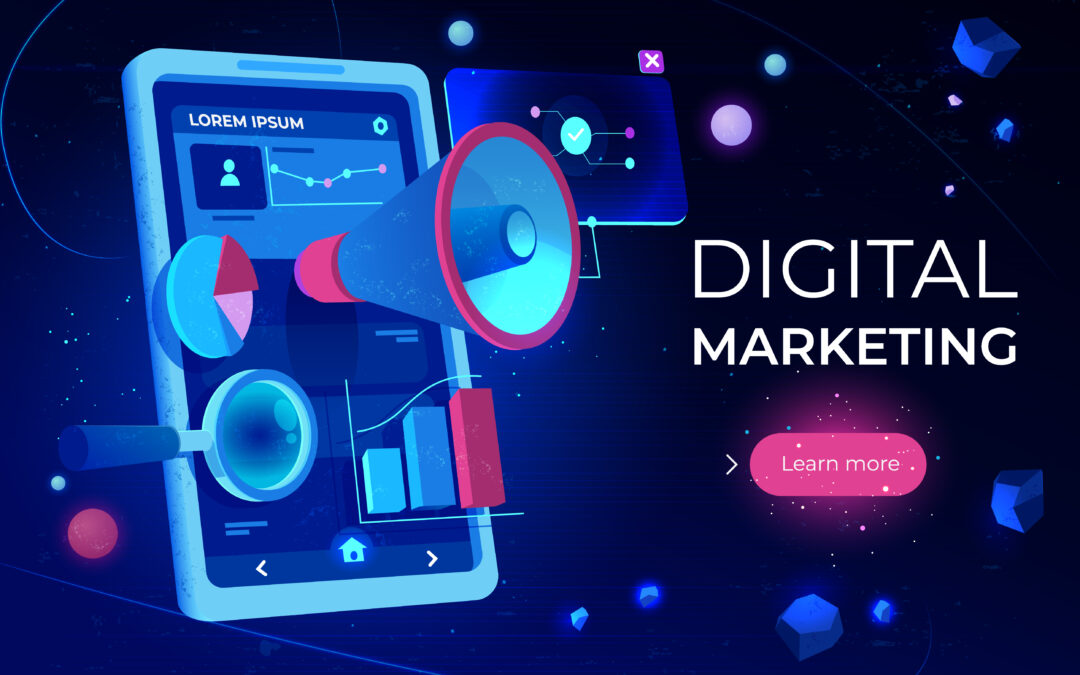
Oct 4, 2023 | Blogs
Digital marketing has transformed the way businesses connect with their audience. It is a general phrase that encompasses more than one or two terms. For newcomers in particular, the amount of industry-specific jargon can be daunting. But understanding this jargon is crucial If you’re actually interested in researching digital marketing. Whether you’re a business owner trying to increase your online presence or a beginning marketer, grasping these terms is your first step toward mastering the art of digital promotion. Furthermore, We take this comprehensive guide just for you so you can get better knowledge about all this jargon. In this article, we’ll break down the essential terms and concepts to help you navigate the digital marketing landscape with confidence!
What is digital marketing?

The initial objective of anyone starting a new business, no matter what it is, is for people to become aware of the business. If they are unaware of its existence, tell how people came across it. So the very first step is to keep people informed about it. To do so he started brand awareness of his business. Note it is brand awareness, not digital marketing. So what is digital marketing? Marketing is all about data-driven and focusing on conversions. Digital marketing encompasses a wide range of strategies and tactics aimed at promoting products or services online. Moreover, It’s an ever-evolving field, and to excel in it, you need to familiarize yourself with the jargon. Let’s break it down.
Search Engine Optimization (SEO)
SEO is the cornerstone of digital marketing. It’s the process of optimizing your website to rank higher in search engine results. In addition, By focusing on keywords, meta tags, and high-quality content, you can improve your website’s visibility and attract organic traffic. To succeed in the digital landscape, understanding SEO is non-negotiable. Mastering SEO involves:
On-Page SEO
On-page SEO involves optimizing individual web pages to rank higher and earn more relevant traffic. Moreover, this includes optimizing titles, headings, and content, as well as improving site speed and mobile-friendliness. In on page SEO different relevant keywords are utilized to increase the visibility in search engine results.
Keywords: These are the words or phrases people use to search for information online. Incorporating relevant keywords into your content is key. These keywords are found using thorough keyword research and identify the most relevant and cost-effective keywords for your business.
Off-Page SEO
Off-page SEO focuses on external factors that influence your website’s rankings. It involves activities that enhance your site’s visibility and credibility in the vast online landscape. While on-page factors like keyword optimization and content quality are crucial, off-page factors also have great impact to strengthen your SEO efforts. This includes backlink building, social media marketing, and online reputation management.
Backlinks: backlinks are the main part of Off-page SEO. Backlinks are links from other websites to yours. Quality backlinks boost your site’s authority.The more high-quality backlinks you have, the better your website’s chances of ranking higher on search engine results pages (SERPs).
Meta Tags:
Meta tags are snippets of HTML code that provide information about the content of a web page to search engines. These tags include the title tag, meta description, and meta keywords. Crafting effective meta tags can improve your click-through rate.
White Hat vs. Black Hat SEO
White hat SEO refers to ethical optimization practices that align with search engine guidelines, while black hat SEO employs questionable tactics that can lead to penalties. It’s crucial to stick to white hat methods for long-term success.
Pay-Per-Click (PPC) Advertising
Pay-Per-Click advertising is an online advertising model that allows businesses to display ads on search engines and pay a fee each time their ad is clicked. It’s essential for businesses aiming to drive immediate traffic to their websites and also a cost-effective way to reach a specific audience. Moreover, Key PPC terms include:
- Ad Auction: The process search engines use to determine which ads to show and in what order. Different online platforms like Google ads and facebook ads used this Ad Auction to decide better which ad display to other users.
- Ad Rank and Quality Score: Ad rank determines the position of your ad in search results. Quality score, on the other hand, assesses the quality and relevance of your ads and keywords on the landing page. Moreover, A higher quality score can lower your advertising costs.
- Click-Through Rate (CTR): CTR measures the effectiveness of your ads. The ratio of users who click on an ad to the number of total users who view it. It’s calculated by dividing the number of clicks by the number of impressions. A high CTR indicates that your ads are resonating with your target audience.
- Cost-Per-Click (CPC): CPC refers to the amount you pay for each click on your ad. It’s determined by several factors, including bid amount and ad quality.
Content Marketing
Content is king in the digital realm. Moreover, Content marketing is the strategic creation and distribution of valuable, relevant, and consistent content to attract and engage a target audience. Here’s which factors contribute to the content marketing:
- Content Strategy: In order to draw in and keep the attention of a target audience, a well-defined content strategy calls for the creation and distribution of worthwhile, relevant, and consistent content. It promotes brand credibility and trust.
- Blogging and Guest Posting: Blogging and guest posting are essential content marketing tactics. They allow you to share valuable insights, establish thought leadership, and reach a wider audience.
- Content Calendar: A content calendar helps plan and schedule your content in advance. It ensures a consistent posting schedule and aligns with your marketing goals.
- Evergreen Content: Evergreen content remains relevant over time. Moreover, It continues to drive traffic and engagement long after its initial publication.
- Call to Action (CTA): Encouraging users to take a specific action, such as signing up for a newsletter or making a purchase.
- Bounce Rate:
- The percentage of visitors who leave a website after viewing only one page.
Social Media Marketing
In the age of social media, this term is a must-know. Social media marketing involves using platforms like Facebook, Instagram, and Twitter to promote your brand or products. Furthermore, Key concepts in social media marketing:
- Social Media Platforms: A great example of Various social media platforms included such as Facebook, Twitter, and Instagram, that provide opportunities to connect with your audience and also promote your brand.
- Engagement Rate: Engagement rate measures how actively your audience interacts with your social media content. Additionally, It includes likes, comments, shares, and clicks.
- Influencer Marketing: Influencer marketing involves partnering with individuals who have a significant following on social media. They can promote your products or services to their engaged audience.
- Viral Marketing: Viral marketing aims to create content that spreads rapidly through social networks. Moreover, It leverages the power of sharing to increase brand visibility.
Email Marketing
Additionally, Email marketing is a very crucial step in digital marketing and has a 4400% ROI. Email marketing Is the process of sending a commercial and unique message to your target audience for the purpose of promoting your product or service.
- Building an Email List: Building a quality email list is crucial for effective email marketing. Additionally, It involves obtaining permission from individuals to send them emails.
- Open Rate and Click-Through Rate (CTR): The open rate measures how many recipients open your email, while CTR measures how many click on links within the email. These metrics indicate the success of your email campaigns.
- Autoresponders: Autoresponders are automated email sequences that deliver content or messages to subscribers at specific intervals. They nurture leads and maintain engagement.
- A/B Testing: A/B testing involves comparing two versions of an email to determine which one performs better. Moreover, After analyses of both versions, you make the decision about which one will work best for you. It helps optimize email campaigns for higher conversion rates.
Analytics and Data
Monitoring the success of your website-building efforts is crucial if you want it to be successful. Utilize analytics to monitor the effectiveness of your material and make adjustments. By keeping an eye on certain critical indicators, you can gauge how well your website is performing. Among these crucial metrics are:
- Key Performance Indicators (KPIs): KPIs are metrics that track the success of your digital marketing efforts. Furthermore, Common KPIs include website traffic, conversion rate, and customer acquisition cost (CAC).
- Conversion Rate Optimization (CRO): CRO focuses on improving the percentage of website visitors who take a desired action, such as making a purchase or filling out a contact form.
- Customer Relationship Management (CRM): CRM software helps manage and analyze customer interactions throughout the customer lifecycle. Moreover, It enhances customer retention and loyalty.
- Heatmaps: Heatmaps visualize user interactions with your website, helping you identify areas for improvement.
Search Engine Marketing (SEM)
With the use of paid advertising, search engine marketing, also known as SEM, you may get your website to show up on the first page of search engine results (SERP). No matter how much effort and money you invest in SEO and keyword research, there are occasions when your website won’t appear in search results. SEM may be the solution to gaining awareness and accelerating revenues more quickly than SEO alone.
- SEM vs. SEO: SEM encompasses paid advertising on search engines, while SEO focuses on organic strategies. Both are vital for increasing online visibility.
- Google Ads: Google Ads allows businesses to create targeted ads that appear on Google search results pages. Additionally, It offers robust tools for audience targeting and ad tracking.
- Bing Ads: Bing Ads is a platform similar to Google Ads but targets users on the Bing search engine. It’s an alternative to reach a different audience.
- Quality Score and Ad Rank: Quality score and ad rank are essential for achieving better ad placements and lower CPC. They reward high-quality ads and relevant landing pages.
Affiliate Marketing
Affiliate marketing refers to the practice of paying outside publications to direct customers to a company’s goods and services. The commission payment encourages the affiliate third-party publications to look for methods that work best to advertise the business and reach to the wider audience. Different terms related to the Affiliate Marketing include:
- Affiliate Networks: Furthermore, Affiliate networks connect advertisers with publishers who promote their products or services in exchange for a commission.
- Commission Structures: Affiliate programs offer various commission structures, including pay-per-sale, pay-per-click, and pay-per-lead. Moreover, The choice depends on your goals and industry.
- Affiliate Links and Tracking: Affiliate links contain unique identifiers to track sales generated by affiliates. Proper tracking ensures fair compensation for marketers.
- Affiliate Disclosure: Ethical affiliate marketers disclose their affiliate relationships to maintain transparency and trust with their audience.
Conversion Funnel
The different stages that a potential consumer goes through before doing a desired action, such as purchasing a product, subscribing to a service, or signing up for a newsletter, can be visualized using a conversion funnel. Different stages of conversion funnel include:
- Awareness Stage: The awareness stage is the top of the conversion funnel, where potential customers become aware of your brand and offerings.
- Consideration Stage: In the consideration stage, prospects evaluate your products or services and compare them to alternatives.
- Conversion Stage: The conversion stage is where prospects make a purchase or take a desired action, such as signing up for a newsletter.
- Retention and Advocacy Stage: After conversion, nurturing and retaining customers is essential. Moreover, Loyal customers can become advocates for your brand.
User Experience (UX)
The process of creating and enhancing how well a user interacts with all areas of a business is known as user experience design. The total experience is the main focus of UX design, not the graphics. There are certain places where the User Experience matter the most that include:
- Website Navigation: Efficient website navigation ensures that users can find information easily on their site and have a positive experience.
- Mobile Optimization: With the rise of mobile users, mobile optimization is crucial for delivering a seamless experience on smartphones and tablets.
- Page Speed: Fast-loading web pages improve user satisfaction and SEO rankings. Moreover, Users are less likely to bounce from a fast website.
- Usability Testing: Usability testing involves gathering feedback from users to identify and address usability issues on your website.
Lead Generation
In order to draw customers to a brand and the products it offers, lead generation is a business process that combines sales and marketing. It entails using numerous channels, including search, social media, email, and your website, to find, draw, and convert individuals into prospects. Nurturing interest in your goods and services is the goal of lead generation. Several factors include:
- Lead Magnets: Lead magnets are valuable offers, such as ebooks or webinars, that entice visitors to provide their contact information.
- Landing Pages: Landing pages are designed to convert visitors into leads by presenting a clear and compelling offer.
- Call to Action (CTA): CTAs prompt visitors to take a specific action, such as signing up for a newsletter or requesting a demo.
- Lead Scoring: Lead scoring assigns a value to leads based on their behavior and engagement, helping prioritize follow-up efforts.
Retargeting and Remarketing
Retargeting and remarketing are two digital marketing techniques that try to reacquaint visitors with your brand or product after they’ve previously expressed interest in it. You should be aware of their similarities and distinctions before using them into your own marketing strategies.so, let;s see the difference:
- How Retargeting Works: Retargeting displays ads to users who have previously visited your website but didn’t convert. It reminds them of your products or services.
- Dynamic Remarketing: Dynamic remarketing shows personalized ads featuring products or services that users viewed on your website.
- Retargeting Best Practices: Effective retargeting involves creating compelling ads, segmenting your audience, and also setting frequency caps.
- Measuring ROI: Measuring the return on investment (ROI) of retargeting campaigns helps assess their effectiveness and make adjustments.
Inbound vs. Outbound Marketing
To reach your potential customer, inbound and outbound marketing are the two different strategies. Both strategies are different from each other and have their own benefits and challenges. Lets see the main difference between them:
- Inbound Marketing Strategy: Inbound marketing attracts prospects through content and interactions, aligning with their interests and needs.
- Outbound Marketing Tactics: Outbound marketing relies on proactive tactics, such as cold calling and email blasts, to reach a broad audience.
- Combining Both Approaches: Many successful marketing strategies combine inbound and outbound tactics to maximize reach and engagement.
Why choose Zee IT Services?
Experience the power of effective digital marketing with Zee IT Services. Our expert team crafts tailored strategies to boost your online presence, drive traffic, and maximize ROI. From SEO to social media, we’re your partner in success. Elevate your brand with us today!”
Frequently Asked Questions
What is the significance of digital marketing?
Digital marketing allows businesses to reach a wider audience, increase brand visibility, and drive sales in the online world.
How can I improve my website’s SEO?
To enhance SEO, focus on high-quality content, comprehensive keyword research, and building authoritative backlinks.
Is PPC expensive?
PPC costs vary depending on factors like industry and competition. However, with effective targeting, it can provide a strong return on investment.
Why is social media marketing important?
Social media marketing helps build brand awareness, engage with customers, and drive traffic to your website.
What role does content marketing play in SEO?
Content marketing provides valuable content that can attract backlinks, boost search engine rankings, and establish your expertise.
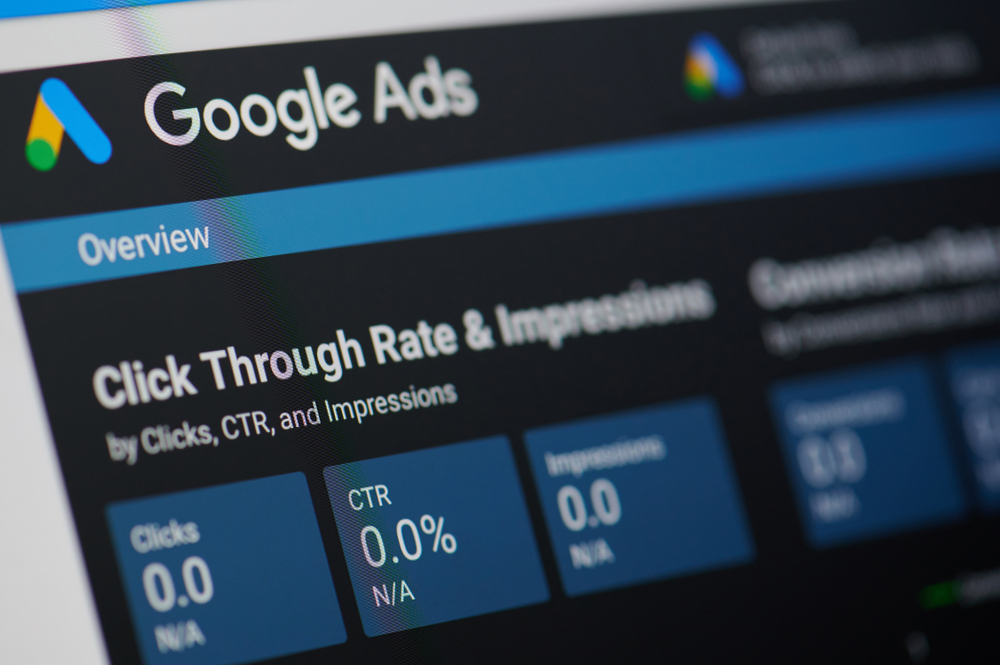
Oct 3, 2023 | Blogs
Businesses are continually looking for efficient ways to contact their target audience and widen their reach in the dynamic world of online marketing. Google Ads is one effective technique that has changed the game. Furthermore, This article will go into the world of Google Ads and consider how it can help your company develop considerably. Moreover, We’ll cover everything, from increasing your online presence to maximizing your return on investment.
What Are Google Ads?
Google Ads, formerly known as Google AdWords, offers a powerful platform for businesses to advertise their products or services to a global audience. This platform was developed by Google and allows businesses to display their ads on Google’s search engine results pages (SERPs) and partner websites. These ads are presented to users when they search for specific keywords related to the products or services offered by the business. Moreover, With over 246 million unique visitors each month, Google is undoubtedly the most popular search engine globally, making Google Ads an invaluable tool for reaching potential customers.
Setting Up Your Google Ads Campaign
Furthermore, Before reaping the benefits of Google Ads, it’s essential to set up your campaign effectively. Here’s how:
Define Your Goals
Before diving into the world of Google ads, you must first define your goals. What do you want to achieve with your advertising campaign? Is it brand awareness, lead generation, or direct sales? Setting clear goals will guide your entire ad creation process. Moreover, In a study conducted by Google, it was found that businesses with specific goals for their Google Ads campaigns are 10% more likely to see a positive return on investment (ROI).
Budget Allocation
Determining your advertising budget is crucial. Your budget will impact the scope and reach of your ad campaign. According to a report by eMarketer, companies that allocate a sufficient budget to their Google Ads campaigns are more likely to outperform their competitors.
Choosing the Right Keywords
Keywords are the foundation of a successful Google ad campaign. You need to select the right keywords to target your audience effectively. Additionally, Extensive keyword research is essential, and keyword research tools like Google Keyword Planner can also help you identify relevant keywords. Moreover, Research indicates that businesses that invest time in comprehensive keyword research see a 10% increase in click-through rates.
Keyword Research
Delving deeper into comprehensive keyword research, it’s vital to analyze search volumes, competition, and trends. In addition, Tools like SEMrush can provide valuable insights into keyword performance. A study by Moz revealed that optimizing for long-tail keywords can increase organic traffic by up to 34%.
Negative Keywords
Don’t overlook negative keywords. These are terms for which you don’t want your ads to appear. Including negative keywords in your campaign can save your budget and improve ad relevance. Research conducted by WordStream found that excluding negative keywords can decrease irrelevant clicks by 15%.
Creating Engaging Ad Copy
Crafting compelling ad copy is an art. It’s not just about describing your product or service; it’s about connecting with your audience’s needs and desires. Moreover, Studies show that ads with emotionally appealing copy have a 10% higher conversion rate.
Crafting Compelling Advertisements
Your ad visuals play a significant role in capturing your audience’s attention. Use high-quality images and videos that resonate with your message. In addition, According to Google, ads with visual elements receive 50% more clicks than text-only ads.
A/B Testing
A/B testing involves creating multiple versions of your ad and testing them to see which one performs best. It’s a data-driven approach to optimization. Research by HubSpot indicates that A/B testing can lead to a 30% improvement in conversion rates.
Optimizing Landing Pages
Your landing page is where your potential customers convert. Moreover, Ensure it’s optimized for a seamless user experience. Studies show that a one-second delay in page loading time can result in a 7% reduction in conversions.
Landing Page Optimization
Continuing the discussion on landing pages, it’s essential to align your landing page with your ad’s message. Additionally, Consistency is key. Research from Marketing Sherpa reveals that maintaining a message match on your landing page can increase conversion rates by up to 55%.
Bid Strategies for Success
Smart bidding strategies can help you maximize your ROI. Google Ads offers various bidding options, including automated bidding. A study by Search Engine Land found that businesses using automated bidding strategies saw a 10-15% reduction in cost per acquisition.
Smart Bidding
Smart bidding leverages machine learning to optimize your bids in real time. It’s a powerful tool for efficiency. Moreover, Google reports that advertisers using smart bidding see a 35% increase in conversions, on average.
Ad Extensions for Extra Impact
Enhance your ads with extensions like site links, callouts, and structured snippets. These provide additional information to potential customers. Moreover, Ad extensions can also improve your ad’s visibility. A study by Google showed that ads with extensions had a 10-15% higher click-through rate.
Measuring and Analysing Performance
Tracking the success of your Google ad’s is vital. Use Google Analytics to measure key metrics like click-through rate, conversion rate, and ROI. Furthermore, Studies have shown that businesses that regularly analyse ad performance are 20% more likely to improve their campaigns.
Tracking Success
Consistently monitoring your ad campaigns allows you to make data-driven adjustments. A study by Word Stream found that advertisers who track their conversions see a 10% increase in ROI.
Continuous Improvement
In the world of Google ads, adaptation is key. Continuously refine your strategies based on performance data and market trends. Research by Statista reveals that businesses that continuously optimize their ad campaigns achieve a 15% increase in ROI year over year.
How Google Ads Can Help You in the Growth of Your Business
Furthermore, Google Ads is not just about driving traffic; it’s about fuelling business growth. Here’s how it can benefit your bottom line:
- Increased Website Traffic: Google Ads can drive a surge in traffic to your website, increasing the chances of conversions.
- Higher Conversions: Targeted ads ensure you reach potential customers at the right moment, leading to higher conversion rates.
- Global Reach: Expand your business’s reach beyond borders and tap into international markets.
- Measurable Results: The robust analytics of Google Ads provide concrete data on your campaign’s performance, helping you make informed decisions.
- Competitive Edge: Stay ahead of your competitors by leveraging Google Ad’s to reach your audience faster and more effectively.
- Adaptability: Modify your campaigns to align with changing market trends and customer preferences.
Overcoming Challenges
While Google Ads can be highly effective, it’s not without its challenges. Common issues include high competition and ad fatigue. Moreover, Strategies like refining your keywords and ad copy can help overcome these challenges.
Frequently Asked Questions
How much should I budget for a Google Ads campaign?
The budget for your Google Ads campaign depends on your business goals, industry, and competition. Moreover, Start with a budget you’re comfortable with and adjust it as you monitor performance.
Are Google Ads suitable for small businesses?
Yes, Google Ads can be beneficial for small businesses. It allows you to reach a highly targeted audience, and you have control over your budget.
How long does it take to see results from a Google Ads campaign?
The time it takes to see results can vary, but you can start seeing initial results within a few weeks. Additionally, Continuous optimization will lead to more significant results over time.
What is the Quality Score in Google Ads?
Quality Score is a metric that measures the relevance and quality of your ads, keywords, and landing pages. A higher Quality Score can lead to lower costs and better ad placements.
Can I run Google Ads alongside other marketing strategies?
Yes, Google Ads can complement other marketing strategies such as SEO and social media marketing. Moreover, Combining these approaches can enhance your overall online presence.

Sep 26, 2023 | Blogs
Staying competitive in the constantly changing world of e-commerce requires a smart strategy. Google Shopping Optimisation is one of your most effective techniques. Shopping is like finding the Holy Grail. It’s a game-changer rather than just another marketing strategy. Utilizing this platform to its fullest extent can help you grow your internet business to new heights. Online shops must optimize their Google Shopping presence in order to succeed in this competitive environment.
One of the most well-known online buying options is Google Shopping. In fact, 35% of Americans prefer to shop online using Google. Google Merchant Centre and Google Ads are the two platforms that makeup Google Shopping. Your product data stream is stored in Google Merchant Centre, and Google Ads is where you can create and optimize campaigns, set spending limits, and modify your bid strategy. E-commerce has revolutionized the way we shop, and Google Shopping is at the forefront of this digital transformation. In this comprehensive guide, we’ll delve into the world of Google Shopping feeds and explore why optimizing them is crucial for your business. Whether you’re a seasoned e-commerce professional or just starting, understanding the ins and outs of this strategy is a game-changer. This article will equip you with the knowledge and strategies needed to succeed. So let’s get started!
What is Google Shopping?
Google Shopping is a service that allows e-commerce businesses to display product listings directly within Google’s search results. These listings include essential product information such as images, prices, and store details. By showcasing your products in a visually appealing way, you can capture the attention of potential customers. Why should e-commerce businesses pay attention to Google Shopping? Well, the benefits are manifold. It drives highly targeted traffic, improves conversion rates, and enhances brand visibility. Plus, it’s cost-effective, allowing you to pay only when users click on your product listings.
Why Google Shopping Matters
Now let’s understand why Google Shopping is so important for e-commerce businesses.
- Maximizing Visibility: Google Shopping allows your products to appear prominently in search results, increasing your visibility to potential customers.
- Higher Conversion Rates: Studies show that users who click on Google Shopping ads are more likely to convert into customers, making it a lucrative platform for e-commerce.
- Targeted Advertising: Google Shopping allows you to target specific keywords and demographics, ensuring that your products are displayed to a relevant audience.
What is Google Shopping Optimization?
Google Shopping Optimization is a multifaceted strategy aimed at maximizing the visibility and profitability of your e-commerce store on Google’s shopping platform. It involves various techniques and best practices that work together to ensure your products are seen by the right audience, ultimately driving more sales. Through effective optimization, you can maximize your return on investment (ROI) and achieve your e-commerce goals.
Market Research and Competitor Analysis
Understanding your target audience is crucial for Google Shopping’s success. Conduct thorough research to identify your ideal customers, their preferences, and their online behavior. After identifying your audience, do a Competitor analysis that helps you to gain a competitive edge. Study your competitors’ ads, keywords, and pricing strategies to identify opportunities and areas for improvement.
Create a Google Merchant Center Account
To Start your Google Shopping journey, the first step is to create a Google Merchant Center account. This account will serve as the foundation for your product listings on Google Shopping.
Getting Started
Setting up your Google Merchant Center account is straightforward. Visit the Google Merchant Center website and sign in with your Google account. If you don’t have a Google account, you can easily create it. Once you’ve logged in,take the following actions:
- Provide your business information, including the name, website URL, and business location.
- Verify and claim your website to confirm ownership.
Adding Product Data
After creating your account, it’s time to add your product data. Your product data feed is the backbone of your Google Shopping campaigns. This includes details such as product titles, descriptions, prices, and images. Craft compelling and informative product titles and descriptions that entice users to click on your listings. Incorporate relevant keywords naturally to improve visibility of e-commerce sites. Ensure that your product data is accurate and up-to-date and it’s structured correctly.
Product Feed Optimization
Optimizing your product feed is essential to ensure your products appear prominently in Google Shopping search results. Continuously optimize your product data feed by updating product details, ensuring consistency, and complying with Google’s feed requirements.
Keyword Research
Start by conducting comprehensive keyword research because effective keyword research is the foundation of successful Google Shopping campaigns. Identify relevant keywords that potential customers might use when searching for your products. Use tools like Google Keyword Planner to discover high-traffic keywords in your niche and those that align with your products.
High-Quality Images
The power of visuals cannot be overstated in e-commerce. Use high-quality images that showcase your products from various perspectives. Customers should be able to zoom in and see every detail. Clear and engaging images can significantly impact click-through rates.
Compelling Product Descriptions
Write compelling and unique product descriptions that highlight the benefits and features of your products. Use persuasive language to convince potential buyers that your product is the solution they’ve been looking for.
Utilize Google Ads
Google Ads is a powerful tool to enhance the visibility of your products. Let’s explore how to make the most of this advertising platform. Link your Google Merchant Center account to Google Ads to create and manage shopping campaigns effectively. Optimize your ad schedule to display ads when your target audience is most active. Allocate your budget strategically to ensure consistent visibility throughout the day.
Bid Management
Bid management involves setting the right bid for your products. Ensure that your bids align with your budget and target audience. Determine the right bid amounts for your products. Consider factors like product margins, competition, and ROI when setting bids. Depending on the objectives of your campaign, choose between manual and automated bidding tactics. Manual bidding offers more control, while automated bidding leverages machine learning for optimization. Regularly evaluate the effectiveness of your bids and make any necessary adjustments.
Budget Allocation
Allocate your budget wisely across your advertising campaigns. Focus on products that have a higher ROI and allocate more budget to them. Spend your money carefully to maintain a continuous presence all day. This strategy will maximize your advertising dollars.
Monitoring and Optimization
Monitoring and optimizing your Google Shopping account is an ongoing process to ensure continued success. To gauge the effectiveness of your Google Shopping campaigns, you must monitor key metrics like CTR, conversion rate, and return on ad spend (ROAS). These metrics offer insightful information about the effectiveness of your campaign.
Regular Performance Analysis
Regularly analyze the performance of your products and campaigns. Frequently analyze your campaigns to identify top-performing and underperforming products or keywords that need adjustment and identify areas where improvements are needed. Track conversions and measure the ROI of your Google Shopping campaigns. This data provides insights into which products and strategies are the most profitable.
A/B Testing
A/B testing allows you to compare different elements of your product listings, such as images, titles, or descriptions. Test variations and implement changes based on what resonates best with your audience.
Mobile Optimization
Considering the popularity of mobile shopping, ensure that your product listings are mobile-friendly and provide a seamless user experience for mobile users. To do this Consider implementing Accelerated Mobile Pages (AMP) to improve the speed and performance of your product pages on mobile devices. Also Tailor your ad extensions to be mobile-responsive, providing users with valuable information even on smaller screens.
Remarketing Strategies
Remarketing is a game-changer when it comes to re-engaging potential customers. Let’s explore the various strategies.
- Remarketing Lists for Shopping Ads (RLSA) allows you to reconnect with users who have previously visited your website. You can tailor your bids and ads to this specific audience, increasing the likelihood of conversions.
- Dynamic Remarketing takes personalization to the next level. It displays customized ads featuring products that the user has viewed on your site. This level of personalization can significantly boost your conversion rates.
- Cross-selling and up-selling are tried-and-true techniques to increase the average order value. Implement these strategies by showcasing related or higher-priced products when a customer is making a purchase.
Customer Reviews and Ratings
Customer reviews and ratings play a pivotal role in building trust and credibility with potential buyers. Encourage satisfied customers to leave reviews. You can do this by sending follow-up emails, offering incentives, or making the review process effortless. Negative feedback is inevitable, but how you handle it matters. Respond promptly, acknowledge the issue, and offer solutions to demonstrate your commitment to customer satisfaction. Moreover, Displaying your ratings in ads can significantly impact click-through rates. Make sure you integrate review extensions and showcase your excellent ratings.
Why choose Zee IT Services?
Elevate your online presence with Zee IT Services! Our knowledgeable team is a specialist in Google Shopping and SEO optimisation, propelling your company to the top of search results and boosting your e-commerce success. We provide the answers you need to succeed in the online market, from keyword expertise to appealing product listings. With Zee IT Services at your side, conquer rather than merely compete.
Frequently Asked Questions
How can I start with Google Shopping Optimization?
Begin by creating a Google Merchant Center account and linking it to your e-commerce website. Then, optimize your product feed with detailed information and high-quality images.
Are there any costs associated with Google Shopping?
While setting up a Google Merchant Center account is free, you’ll need a budget for advertising costs. You pay when someone clicks on your ad (Pay-Per-Click or PPC).
How important is keyword research in Google Shopping?
Keyword research is crucial as it determines when and where your products appear in search results. It’s the foundation of a successful optimization strategy.
Are there any specific tools to help in Google Shopping optimization?
Yes, there are various tools and software available to streamline the optimization process, such as Google Ads Editor and SEMrush.
How can I measure the success of my Google Shopping campaigns?
Utilize Google Analytics and the data provided in your Google Ads account. Track metrics like conversion rate, click-through rate, and return on ad spend (ROAS).
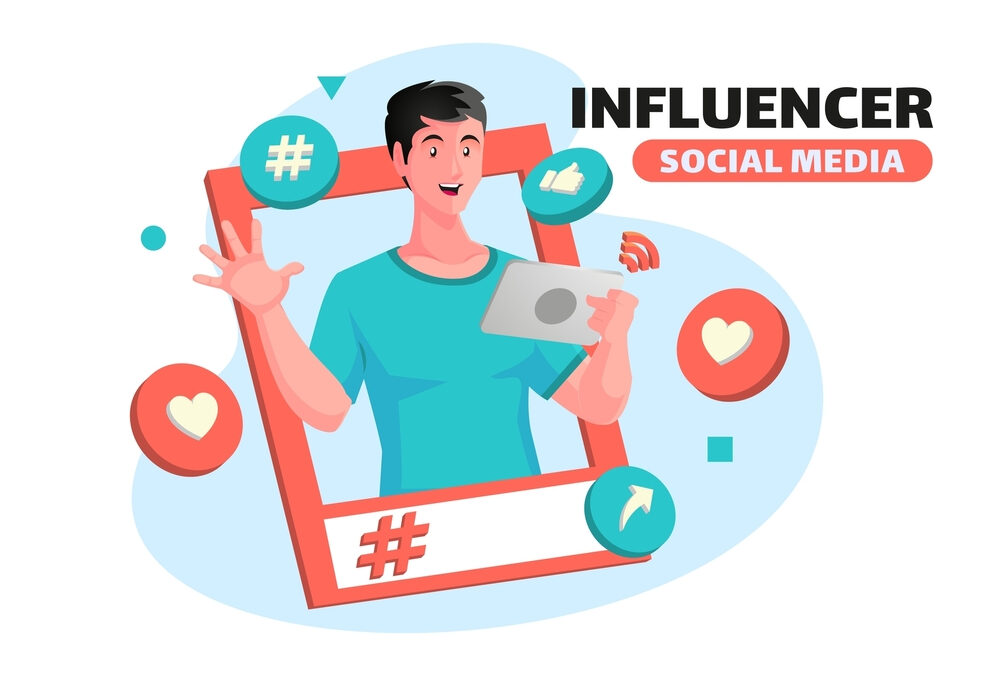
Sep 25, 2023 | Blogs
In today’s highly competitive world, businesses are constantly seeking innovative ways to enhance their presence on the web. One such effective seo strategy that has gained significant momentum in recent years is influencer marketing. It’s a tool that has the power to take your brand to new heights, giving it the attention it deserves and instantly reaching millions of people. The number of searches for the term “influencer marketing” on Google search alone has increased by 465%. But what is actually influencer marketing?
Influencer marketing is a strategy that involves collaborating with individuals who have a significant following and influence on social media platforms to promote products, services, or brands. Its relevance in SEO lies in the potential to enhance organic search engine rankings by leveraging influencers’ reach and credibility. The effectiveness of influencer marketing depends on the way it engages audiences. For every $1 invested in influencer marketing, companies generate a return on investment of $5.2 and so many other benefits it gives to businesses. To learn more about this fantastic tool to improve your marketing approach, keep reading this post. Because, In this article, we will explore the power of influencer marketing in the realm of SEO and how it can be leveraged effectively to achieve organic growth on social media.
What is Influencer Marketing?
Influencer marketing is a dynamic digital marketing strategy that involves collaborating with individuals who possess a strong online presence and a dedicated following, often referred to as influencers. These influencers can be bloggers, social media stars, YouTubers, or celebrities who have cultivated a loyal audience in a specific niche or industry. Compared to mainstream stars, YouTubers are 17 times more engaging and 11 times more extraordinary.
The Rise of Influencer Marketing
Over the past decade, influencer marketing has experienced exponential growth, becoming a significant player in the world of online advertising. Its rise can be attributed to several factors, including the decline in the effectiveness of traditional advertising methods and the increasing skepticism of consumers towards overtly promotional content.Influencer marketing has filled the gap by offering a more authentic and relatable approach to brand promotion. When an influencer endorses a product or service, their audience perceives it as a genuine recommendation from someone they trust, making it a powerful tool for marketers.
The impact of influencer marketing on consumer behavior
The influence of social media influencers extends beyond mere recommendations. Studies have shown that consumers are more likely to make purchasing decisions based on the opinions and experiences shared by influencers. 46% of social media users have bought things that influencers have recommended. This influence can be attributed to the personal connection that influencers establish with their followers, creating a sense of trust and reliability. Moreover, influencer marketing has the potential to drive engagement and increase brand awareness, both of which are crucial elements of SEO success. Social signals, such as likes, shares, and comments generated by influencer content, can positively impact a website’s search engine ranking.
How influencer marketing fits into growth marketing
Influencer marketing seamlessly integrates with growth marketing strategies. As businesses aim for sustainable growth, leveraging influencers can provide a significant boost. By aligning influencer collaborations with overarching growth objectives, companies can achieve higher brand visibility, expand their customer base, and ultimately increase revenue.
How Influencer Marketing Transforms Your SEO
The power of influencer marketing in the realm of SEO is significant and can be leveraged effectively to achieve organic growth on social media. Here’s how:
Quality Backlinks:
Influencer marketing can help you acquire high-quality backlinks to your website. When influencers create content that links back to your site, it boosts your website’s authority and search engine rankings. Search engines consider these backlinks as a vote of confidence in your content’s relevance and quality.
Increased Social Signals:
Influencers often have large and engaged social media followings. When they share or promote your content, it generates social signals (likes, shares, comments) that indicate content quality to search engines. Social signals can indirectly influence SEO rankings.
Content Amplification:
Influencers can amplify your content to a wider audience, increasing its visibility. According to a report, 42% more people engage with influencer content. This can lead to more people discovering and sharing your content, which can result in organic growth on social media and improved SEO performance.
Enhanced Content Strategy:
Collaborating with influencers can provide fresh and diverse content perspectives. This enriches your content strategy and caters to a broader audience, which can positively impact both social media engagement and SEO.
Keyword Relevance:
Influencers often create content around specific topics and do comprehensive keyword research to find the keywords relevant to their industry. This can help your website rank for these keywords, especially when influencers incorporate them naturally into their content.
Local SEO:
Local influencers can boost your local SEO efforts. When they mention your business in their content or share your products or services, it can improve your local search rankings, making your business more discoverable to nearby customers.
Trust and Credibility:
Influencers are trusted by their followers. When they endorse your brand or products, it can enhance your credibility and trustworthiness in the eyes of both consumers and search engines. 94% of marketers think that the secret to successful influencer marketing is credibility and trust. Let’s learn how to use influencer marketing efficiently to achieve organic social media growth now:
How to Leverage Social Media for Business Growth
There’s no doubt Social media has transformed from a purely personal connection platform to a potent tool for businesses to increase their reach and encourage expansion.
Define Your Goals:
The first and foremost step in leveraging social media for business growth is to define your goals clearly. What do you aim to achieve through your social media presence? Identifying these goals will provide you with a strategic direction and help you measure your progress such as:
- Increasing Brand Awareness: If your goal is to enhance your brand’s visibility, focus on creating content that showcases your brand identity and values. Consistent posting and engagement with your audience can help build brand recognition.
- Boosting Sales: If your primary aim is to drive sales, consider running targeted ad campaigns on social media platforms. Utilize compelling visuals and persuasive copy to encourage conversions.
- Engaging with Customers: Social media is an excellent platform for engaging with your customers. Respond promptly to comments and messages, and encourage feedback to build customer loyalty.
Find the Right Influencers
Collaborating with influencers can be a game-changer for your social media strategy. However, it’s crucial to find influencers who align with your brand and target audience. Here’s how to go about it:
- Identify Your Niche: Determine the niche or industry your business operates. Look for influencers who have a substantial following within that niche.
- Check Authenticity: Authenticity is key. Investigate an influencer’s authenticity by examining their engagement rates and audience demographics. Avoid influencers with fake or purchased followers.
- Engage in Outreach: Reach out to potential influencers with a well-crafted proposal. Explain how your collaboration can be mutually beneficial and showcase what your brand has to offer.
Develop a Strategy
A well-defined social media strategy is your roadmap to success. Consider the following when creating your strategy:
- Content Calendar: Develop a content calendar outlining what, when, and where you’ll post. Consistency is crucial in maintaining audience engagement.
- Content Types: Diversify your content types, including images, videos, infographics, and written posts. Tailor your content to resonate with your target audience.
- Platform Selection: Choose the social media platforms that align with your audience. Not all platforms are equally effective for every business.
- Ad Campaigns: If your budget allows, invest in paid advertising campaigns on social media. Targeted ads can yield impressive results.
Measure Success
Measuring the success of your social media efforts is essential for refinement and growth. Key performance indicators (KPIs) to track include:
- Engagement Rates: Monitor likes, shares, comments, and overall interaction with your content.
- Follower Growth: Track the growth of your follower count over time.
- Click-Through Rates (CTR): Measure how often your audience clicks on links in your posts.
- Conversion Rates: If your goal is sales or lead generation, track the percentage of social media visitors who take the desired action, such as making a purchase or signing up for a newsletter.
- Return on Investment (ROI): Calculate the ROI of your social media marketing efforts by comparing the revenue generated against your investment.
Best practices for influencer marketing
To harness the power of influencer marketing effectively, businesses must adhere to best practices:
Find the Right Influencers
As we already discussed about it, Identifying the right influencers is paramount. It’s essential to partner with individuals whose values align with your brand and whose audience matches your target demographic. Tools and platforms can aid in influencer discovery and evaluation.
Develop a Strategy
A well-defined strategy is key to success. Determine the goals of your influencer marketing campaign, whether it’s increasing brand awareness, driving website traffic or improving website traffic , or boosting sales. Create a clear plan outlining content collaboration, posting schedules, and performance metrics.
Measure Success
Measuring the success of influencer marketing campaigns is crucial for optimization. Utilize analytics tools to track key performance indicators (KPIs), such as engagement rates, click-through rates, and conversion rates. Adjust your strategy based on the data collected.
Influencer marketing vs. traditional advertising
Influencer marketing offers a refreshing departure from traditional advertising. While traditional methods involve mass communication, often leading to ad fatigue, influencer marketing delivers personalized messages to a receptive audience. Additionally, influencer content tends to be less intrusive, enhancing the overall user experience.
Frequently Asked Questions:
What is influencer marketing, and how does it impact SEO?
Influencer marketing involves partnering with individuals with a substantial social media following to promote your brand. It impacts SEO by generating backlinks and increasing brand visibility, which increase website’s ranking on serps.
How do I choose the right influencers for my brand?
Choosing the right influencers involves evaluating their relevance to your industry, the authenticity of their content, and the demographics of their followers. Utilize influencer marketing platforms to streamline this process.
Can influencer marketing replace traditional advertising completely?
While influencer marketing offers unique advantages, it is most effective when integrated into a holistic marketing strategy. It can complement traditional advertising efforts by providing a more personal touch.
Is influencer marketing suitable for all types of businesses?
Influencer marketing can benefit a wide range of businesses, but its effectiveness may vary depending on the industry and target audience. Conduct thorough research to determine if it aligns with your goals.
What metrics should I track to measure the success of my influencer marketing campaigns?
Key performance indicators (KPIs) for influencer marketing include engagement rates, click-through rates, conversion rates, and return on investment (ROI). These metrics help gauge the impact of your campaigns.
Page 5 of 19« First«...34567...10...»Last »

